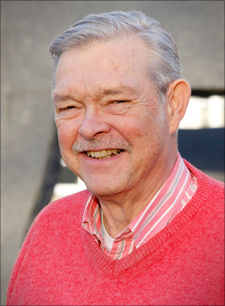Professor Carl Christian Tscherning (1942-2014), former General Secretary of the International Association of Geodesy and editor of Bulletin Geodesique, and a charismatic, outspoken, and grand master of geodesy, died unexpectedly on October 24, 2014, from complications following operations for intestinal problems. During Christian’s nearly 45 years of work with and for geodesy, including many years working actively for the International Association of Geodesy, Christian marked himself as a top level scientist especially in physical geodesy (“Mr. Collocation”), developing novel and advanced methods, always with a strong view on applications and practical software implementations, and being an inspirator, teacher and mentor for a long list of new generation students in geodesy and geophysics over the years.
Christian was born in Copenhagen in 1942, and already during his study years did he show his talent for quick decisions, outspokenness and political sense, as chairman for various student bodies during the turbulent years of the late 1960’s, and his parallel education as officer in the Danish military reserve forces. He got his M.Sc. in geodesy 1970, and then joined the Danish Geodetic Institute. In his younger years he took part in geodetic survey expeditions to Greenland (and early got renowned for his on-site commandeering of a Danish Navy helicopter to relieve a construction of a new astronomic pillar, saving his team mates many mountain backpacking trips with cement). His career at the Geodetic Institute involved both theoretical and practical geodesy, and he advanced to a position as State Geodesist shortly before he was appointed professor of geodesy at Copenhagen University in 1988.
His professorship at the Niels Bohr Institute, Copenhagen University, saw a broadening of his activities into satellite and classical geodesy, and supervision of a long list of M.Sc. and ph.d.-students, making sure a Danish tradition in geodesy was maintained, and passed on to a new generation of scientists. Christian truly enjoyed the interaction with the students, and they enjoyed his continuous enthusiasm and support. It was characteristic that Christian treated all persons attentive and nice, irrespectively of whether it was students, professors, kitchen staff, or visitors from far away. After his formal retirement in 2013 he continued as professor emeritus and consultant, active with planning of new geoid- and space-related trips up to a few days before his death.
Christian was a very visible and influential person in the international geodetic cooperation, starting with a longer research stay at Ohio State University in the early 1970’s, and followed up by several later shorter research stays, hosted by leading colleagues at institutions in the US and Europe. The development of the “Tscherning-Rapp” covariance model, the collocation software, including the early utilization of high-degree geopotential models, and lately his work in connection with GOCE, all show his involvement in state-of-the art physical geodesy. Scientific symposia with Christian present, either as speaker or a loud-spoken member of the audience, were never dull. Few people escaped Christian’s pointed questions at scientific conferences, but such questions nearly always seemed intended to strengthen other people’s research and make the field of geodesy more robust.
Christian’s scientific production was more than 290 papers and technical reports. He has supervised more than 25 ph.d. students.




